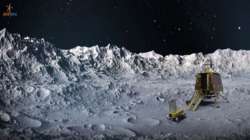Chandrayaan-2's orbiter capable of achieving "better results": Former ISRO Chief Kiran Kumar
Elaborating, Kumar said that the orbiter this time is equipped with critical instruments aimed at providing excellent results in comparison to Chandrayaan-1, launched more than a decade ago.

Despite losing communication with the Vikram lander and the rover housed inside it, the orbiter of lunar mission Chandrayaan-2 is capable of achieving "better results", former ISRO chief A S Kiran Kumar said on Thursday.
"Except for the final landing activity, all other activities that were planned are intact," Kumar told PTI.
Elaborating, Kumar said that the orbiter this time is equipped with critical instruments aimed at providing excellent results in comparison to Chandrayaan-1, launched more than a decade ago.
Compared to two of the instruments carried by Chandrayaan Chandrayaan-1 from the NASA JPL earlier, this time Chandrayaan-2 hasinstruments which are "outperforming", both in terms of spectral range of three micron to five micron and radars, according to him.
"Instead of one synthetic aperture radar, (this time) we have two frequency radars. So there are many new capabilities in this. Actually it helps us achieve better results," Kumar said.
"We are expecting results far in depth because we will be able to map in permanently shadowed regions using our microwave dual frequency censors.
And then, we have very high resolution cameras and large spectral range", he added.
The Chandrayaan-2, an ambitious project of the ISRO, was launched on July 22.
It comprised three components -- orbiter, moon lander Vikram and rover Pragyan.
The lander was originally planned to touch down on the lunar surface in the early hours of September 7, but just 2.1 km above the moon, it lost contact with ground-stations.
ISRO said on Sunday that cameras on-board the orbiter located the lander on the lunar surface, adding that all possible efforts were being made to re-establish contact with Vikram, which has a mission life of 14 days.
ALSO READ: Chandrayaan 2: Global space agencies applaud ISRO
ALSO READ: EXPLAINED: Why Chandrayaan 2 is still a success even after moon lander lost connection